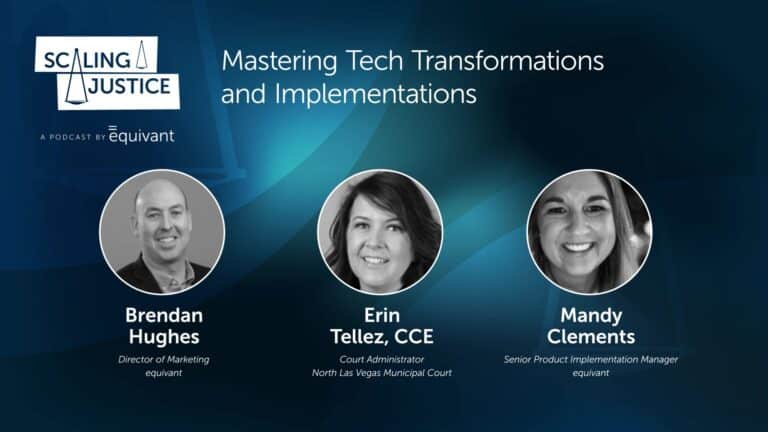By Sherry-Lynn Agcanas-Wolf, Director, Product Management
When the world closed down during the pandemic and people could no longer walk into a courtroom, many courts prioritized adopting technology that facilitated the public. All of this technology had been available prior to the pandemic but having to rely mostly on virtual platforms accelerated technology adaptation by the courts like never before.
This readiness for technological advances has opened up a world of possibilities to improve the current justice system. We know technology enables equity, access, and transparency and is one of the “5 Court Tech Trends We’re Ready to Support in 2023,” as Gary Egner, Director of Business Development, shared.
But how do we keep this momentum going? And what are some of our top considerations, both barriers and benefits, that will impact how we move forward?
Technology will drive accessibility.
Technology providers must ensure that any public-facing portals comply with Web Content Accessibility Guidelines (WCAG) so that they’re accessible to people with diverse needs and capacities.
Providers will also need to ensure that any technological solution can be scaled down and responsive to any type of device. Not everyone has access to a computer or workstation, and any website or portals will have to function equally well across all devices, including mobile phones or tablets.
With the increase of self-represented litigants nationwide, prioritizing accessibility has become imperative. For courts to work with self-represented litigants, they need to offer technology that can be easily used and accessed on all kinds of devices, including mobile phones.
Integrated systems will replace disconnected solutions.
At the start of the pandemic, we saw many courts using different systems based on what was readily available. This approach becomes challenging because available systems don’t always work cohesively. With a virtual courtroom, for example, an online meeting that is not sharing data with the case management system not only makes the process unwieldy and insecure but also leads to duplicating efforts, increasing the chances for errors and ultimately slowing down the entire court process.
Combining the case management system with the online meeting system streamlines the court processes, making them as efficient as possible. For example, if documents are to be signed or reviewed during a virtual court proceeding, an integrated system would allow sharing of these documents back and forth amongst all participants, saving time and ensuring security.
Technology will have to overcome the ‘trust’ barrier.
One of the biggest barriers to more courts adopting technology is being unsure of the platforms’ security. This hesitancy is understandable, considering using technology within courtrooms is still a newer practice.
Courtroom solutions already incorporate security protocols, but as the system adapts and replaces legacy procedures with newer technology, it will be important to make certain that similar safety protocols are being implemented for all public-facing domains.
Insights based on data will drive tailored solutions.
Most of our courts across the country adhere to state reporting requirements, which can include reporting about the kind of depositions that are happening on your cases and how long it takes for those cases to complete. This can be cumbersome, time-consuming, and labor-intensive in a paper-based environment.
Increasing the use of technology across the justice systems not only makes it easier to report but capturing more data through a case management system, public portals, and different kinds of technology makes it easier to find patterns and analyze trends. Identifying the type of criminal offenses in an area for example, can help the courts address the underlying causes and encourage change in that community by offering customized solutions.
Capturing (and reporting) more data not only makes the entire justice system more transparent and consistent but also changes the whole system.
Technology will need to be mobile ‘device’ friendly.
Anyone can now file their paperwork online without having to go to court. Attorneys and even self-represented litigants can use public portals to make payments on their traffic tickets or file civil complaints. While technology has improved how people interact with the court, there are still many limitations to using mobile phones when it comes to courtroom activity. For example, it is difficult to exchange documents between the judge, the attorneys, and the litigants using only a mobile phone.
In an ideal virtual courtroom, we will be able to use any mobile device to share documents amongst the different participants, secure signatures while ensuring that the person who needs to be signing is actually signing, and more.
By embracing new technology, our justice system continues to positively impact millions of people interacting with our courts across the country. But as with any systematic change, embracing new technology comes with its own challenges, some predictable, others unforeseen.
I believe that with our knowledge of technology and the justice system, we can help bridge the gap between what the courts need to streamline their processes and the available technology that will help them get there.
Connect with us to learn more about how our software can improve your court’s virtual technology.
About Sherry-Lynn Agcanas-Wolf
Sherry-Lynn learned the value of civil service from her parents, who worked in local and federal government. When developing solutions, she thinks of them, which makes her passionate about equivant’s mission to simplify justice for all by bringing the best software to agencies that serve the justice community. She has worked in the justice industry for over 20 years. With equivant, she has served in multiple roles that give her a broad perspective of justice solutions. Sherry-Lynn currently leads the equivant product management team as Director.





